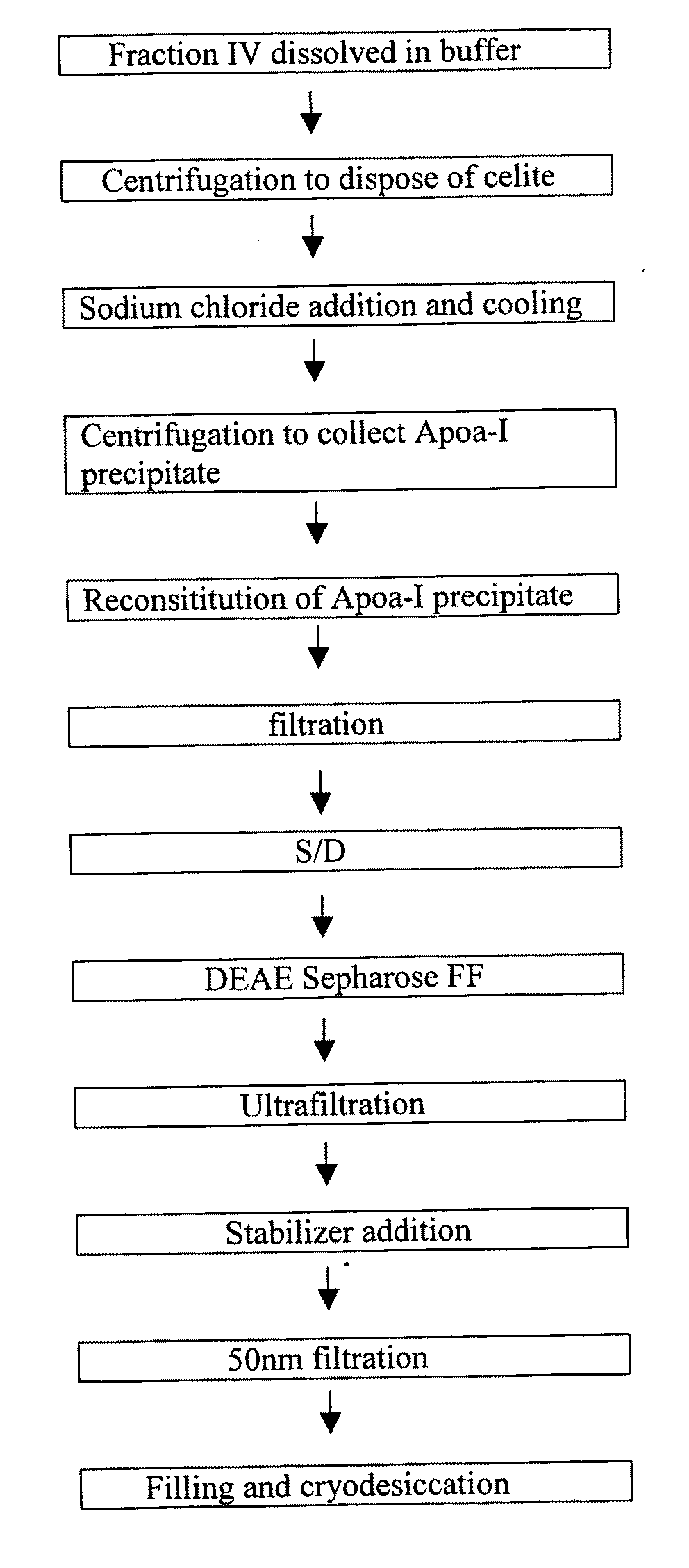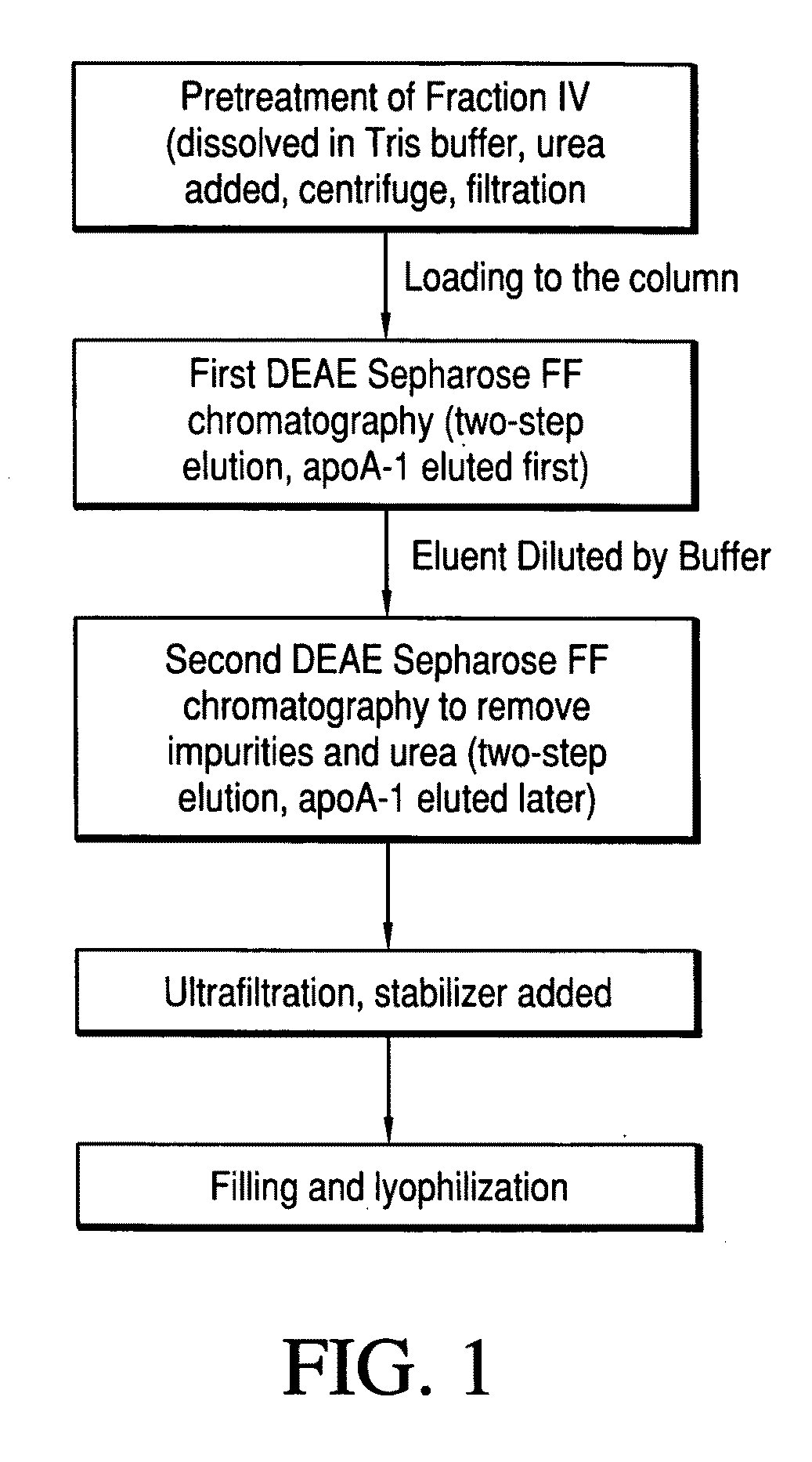Method of purifying apolipoprotein A-1
a technology of apoa-1 and purification method, which is applied in the field of protein preparation, can solve the problems of relativly difficult eluted off the column, and achieve the effects of influencing the behavior of apoa-1, and easy eluted off the column
- Summary
- Abstract
- Description
- Claims
- Application Information
AI Technical Summary
Benefits of technology
Problems solved by technology
Method used
Image
Examples
example 1
ApoA-1 Purification
[0045]The starting materials include: 0.2 g plasma fraction IV, two 5 ml DEAE anion exchange columns (from GE Healthcare), and purification and conductivity determination equipment, namely, an AKTA EXPLORER 100 (from GE Healthcare).
[0046]Plasma Fraction IV Pretreatment
[0047]0.2 g of fraction IV is dissolved in 100 ml Tris buffer (pH 7.8, 4° C.). Urea is added to the solution until the end concentration reaches 6 mol / L and is mixed thoroughly. The solution is centrifuged at 8,000 rpm to remove sediment, then filtrated by a 0.45 μm filter.
[0048]The First DEAE Anion Exchange Chromatography
[0049]A first DEAE column is equilibrated by Tris buffer (pH 7.8) containing 6 mol / L urea. The solution from step (1) is loaded onto the DEAE column at a flow rate of 1 ml / min. Tris buffer (pH 7.8, conductivity 3.5 ms / cm) with a urea concentration of 6 mol / L is used to elute the column. ApoA-1 is eluted. The eluted volume is 20 ml. Four different Tris buffers (each with pH 7.8, and ...
example 2
ApoA-1 Purification
[0054]The 0.2 g of plasma fraction IV and the equipment are the same as those in Example 1.
[0055]Plasma Fraction IV Pretreatment
[0056]The 0.2 g of fraction IV is dissolved in 100 ml Tris buffer (pH 7.8, 4° C.). Urea is added to the solution until the end concentration reaches 6 mol / L, and the solution is mixed thoroughly. The solution is centrifuged at 8,000 rpm to remove the sediment and then filtrated by a 0.45 μm filter.
[0057]The First DEAE Anion Exchange Chromatography
[0058]The first DEAE column is equilibrated by Tris buffer (pH 7.8) containing 1 mol / L urea. The solution from step (1) is loaded onto the first DEAE column at a flow rate of 1 ml / min. Tris buffer (pH 7.8, conductivity 3.5 ms / cm) with a urea concentration of 1 mol / L is used to elute the column. ApoA-1 is eluted. The elute volume is 20 ml. Tris buffer (pH 7.8, 59.2 ms / cm respectively) is used to elute the column, and the impurities are eluted.
[0059]The Second DEAE Anion Exchange Chromatography
[006...
example 3
ApoA-1 Purification
[0061]The 0.2 g of plasma fraction IV and the equipment are the same as those in Example 1.
[0062]Plasma Fraction IV Pretreatment
[0063]The 0.2 g of fraction IV is dissolved in 100 ml Tris buffer (pH 7.8, 4° C.). Urea is added to the solution until the end concentration reaches 6 mol / L, and the solution is mixed thoroughly. The solution is centrifuged at 8,000 rpm to remove the sediment and then filtrated by the 0.45 μm filter.
[0064]The First DEAE Anion Exchange Chromatography
[0065]The first DEAE column is equilibrated by Tris buffer (pH 7.8) containing 8 mol / L urea. The solution from step (1) is loaded onto the DEAE column at a flow rate of 1 ml / min. Tris buffer (pH 7.8, conductivity 3.5 ms / cm) with 8 mol / L urea is used to elute the column. ApoA-1 is eluted. The elute volume is 20 ml. Tris buffer (pH 7.8, conductivity 59.2 ms / cm) is used to elute the column, and the impurities are eluted.
[0066]The Second DEAE Anion Exchange Chromatography
[0067]The procedures are th...
PUM
| Property | Measurement | Unit |
|---|---|---|
| pore size | aaaaa | aaaaa |
| volume ratio | aaaaa | aaaaa |
| volume ratio | aaaaa | aaaaa |
Abstract
Description
Claims
Application Information
 Login to View More
Login to View More - R&D
- Intellectual Property
- Life Sciences
- Materials
- Tech Scout
- Unparalleled Data Quality
- Higher Quality Content
- 60% Fewer Hallucinations
Browse by: Latest US Patents, China's latest patents, Technical Efficacy Thesaurus, Application Domain, Technology Topic, Popular Technical Reports.
© 2025 PatSnap. All rights reserved.Legal|Privacy policy|Modern Slavery Act Transparency Statement|Sitemap|About US| Contact US: help@patsnap.com



